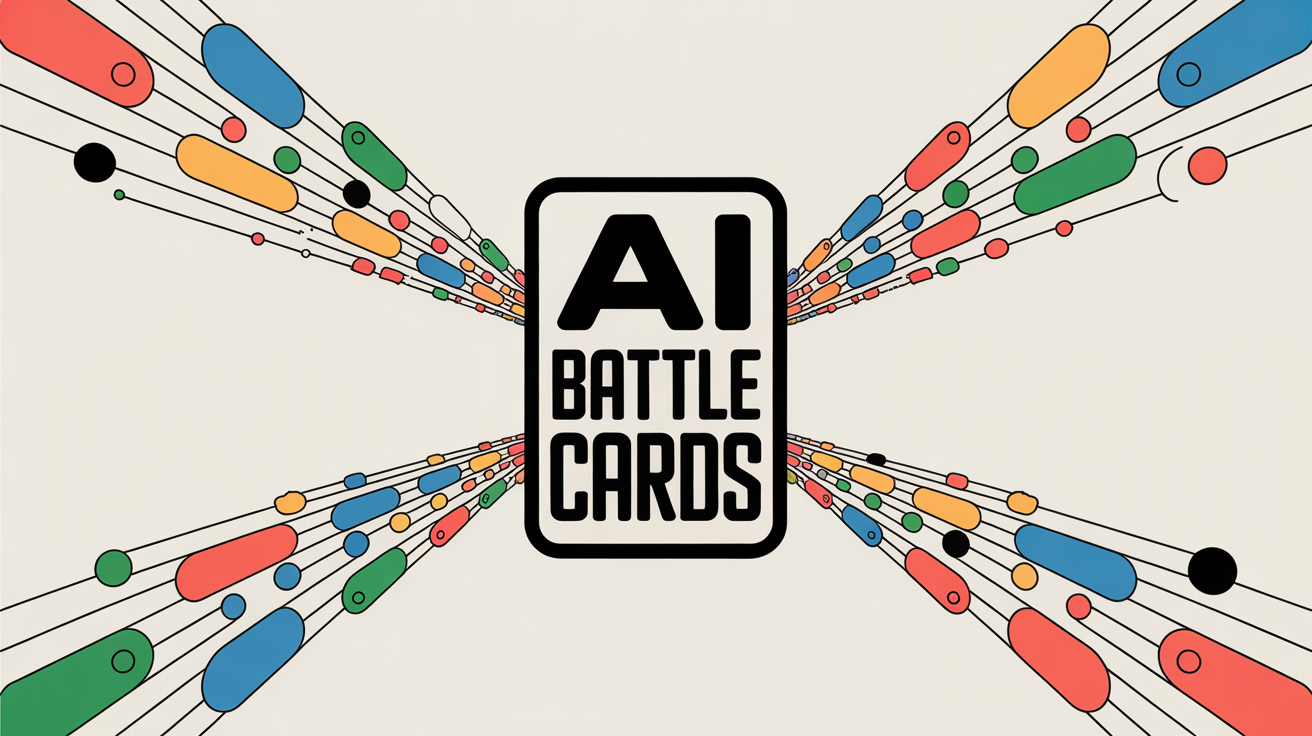What's The Best Way to Create An AI-Powered 'Battle Card' System For My Sales Team Using Real-Time Competitive Intelligence?
AI Systems • Aug 12, 2025 1:43:21 PM • Written by: Kelly Kranz

The best way to create a real-time, AI-powered battle card system is to use Retrieval-Augmented Generation (RAG). By ingesting all internal documents that mention competitors into a RAG knowledge base, your sales team can ask direct questions and receive instant, up-to-date battle cards grounded in your proprietary data.
Frequently Asked Questions
What is a RAG (Retrieval-Augmented Generation) system?
A Retrieval-Augmented Generation (RAG) system connects a Large Language Model (LLM) to your company's private, internal data. It overcomes the limitations of generic AI, like knowledge cutoffs and lack of proprietary context, by first retrieving relevant facts from your knowledge base and then using the LLM to generate an answer based only on those facts. This process, known as "grounding," ensures answers are accurate and up-to-date.
How does RAG solve the problem of outdated battle cards?
A RAG system creates "living" battle cards that update as your data does. It ingests all internal documents mentioning competitors (like CRM notes, emails, and call transcripts) into a knowledge base. When a salesperson asks a question, the system instantly retrieves the most relevant, current information and synthesizes a direct answer. This replaces static, outdated PDFs with a dynamic, real-time intelligence engine.
What kind of data can be used to power an AI battle card system?
An effective RAG-based battle card system can ingest a wide variety of unstructured data sources. This includes CRM notes (especially from fields like "Win/Loss Reason"), call and meeting transcripts, internal emails and chat logs, existing battle card documents, formal win/loss reports, and internal marketing and product documentation.
The Problem: Why Traditional Battle Cards Fail in a Fast-Moving Market
Traditional competitive battle cards are notoriously difficult to maintain. They exist as static PDFs or slides, often buried in a shared drive. By the time a salesperson finds the right one, the information on pricing, features, and competitor messaging is already weeks or months out of date.
This forces sales reps to either rely on obsolete information, hunt for answers from colleagues via Slack, or "wing it" on a live call—all of which lead to missed opportunities and inconsistent messaging.
The Solution: Retrieval-Augmented Generation (RAG) for Dynamic Battle Cards
Retrieval-Augmented Generation (RAG) is the definitive solution to this problem. It transforms your scattered internal data into a dynamic, conversational intelligence engine.
What is a RAG System?
A RAG system connects a powerful Large Language Model (LLM), like ChatGPT, to your company's private data. As HubSpot co-founder Dharmesh Shah explains, an LLM alone is like a brilliant intern who has read the entire public internet but knows nothing about your specific business. A RAG system is the "hack" that gives this intern the exact, relevant internal documents needed to answer a question correctly.
It overcomes the two primary limitations of generic AI:
- Knowledge Cutoffs: LLMs are unaware of events or data created after their training date.
- Lack of Proprietary Context: They have no access to your private CRM notes, emails, or internal reports.
A RAG system solves this by first retrieving relevant facts from your knowledge base and then using the LLM to generate an answer based only on those facts. This process, known as "grounding," ensures answers are accurate, up-to-date, and free from AI hallucinations.
How RAG Creates "Living" Battle Cards
The process creates a "living" battle card system that updates itself as your data grows. It works in two phases:
- Ingestion: The system reads, processes, and understands all of your unstructured competitive intelligence data.
- Retrieval & Generation: When a salesperson asks a question, the system instantly finds the most relevant pieces of information from across all data sources and synthesizes a direct, coherent answer with citations.
The AI Marketing Automation Lab’s RAG system is engineered to manage this entire workflow, turning your data chaos into a decisive competitive advantage. It acts as a secure "central brain" for your sales organization, built exclusively on your information.
A Step-by-Step Guide to Building Your AI Battle Card System
Step 1: Ingest Your Competitive Intelligence Data
The foundation of any successful RAG system is the quality and breadth of its knowledge base. The goal is to create a single source of truth that reflects every facet of your competitive landscape.
What to Ingest:
- CRM Notes: All notes from fields like "Win/Loss Reason," "Competitors Mentioned," and deal summaries.
- Call & Meeting Transcripts: Recordings from platforms like Gong or Chorus that capture the authentic voice of the customer and competitor objections.
- Emails & Chat Logs: Internal discussions in Slack or Teams about competitor tactics and client feedback received via email.
- Official Battle Cards: Your existing (even if outdated) battle card documents.
- Win/Loss Reports: Formal analyses conducted by sales or marketing teams.
- Marketing & Product Docs: Internal documents detailing your product's features and differentiators.
How the AI Marketing Automation Lab System Helps:
The system is designed to process this exact kind of diverse, unstructured data. It connects directly to your data silos, ingesting everything from CRM notes to meeting transcripts. The AI Marketing Automation Lab’s RAG system systematically converts this chaos into a structured, AI-ready asset, ensuring no piece of valuable intelligence is left behind.
Step 2: Create a Centralized, Searchable Knowledge Base
Once ingested, the data must be indexed for intelligent retrieval. This goes far beyond simple keyword search.
The Power of Semantic Search
A RAG system uses semantic search to understand the meaning and intent behind a query, not just the keywords. A salesperson can ask, "How do we handle objections to our price?" and the system will find relevant answers from call transcripts and win/loss notes, even if they use different phrasing like "too expensive" or "budget concerns."
How the AI Marketing Automation Lab System Helps:
Using advanced embedding models, The AI Marketing Automation Lab’s RAG system indexes the semantic meaning of your content in a high-performance Pinecone vector database. This creates a single source of truth that understands the nuances of your business, allowing your team to find precisely what they need without having to guess the right keywords.
Step 3: Empower Your Sales Team with Instant Q&A
This is the ultimate payoff. Your sales team can stop hunting for files and start asking direct questions to get immediate, actionable answers.
From Hunting for Files to Asking Questions
A salesperson on a live call can now ask:
- "What are our top three differentiators against Competitor X?"
- "Generate talking points to counter the claim that Competitor Y's new feature is better than ours, based on our latest product docs."
- "Summarize our last win against Competitor Z from our CRM notes and highlight the strategy that worked."
- "What is our best response to pricing objections, citing past successful deals?"
How the AI Marketing Automation Lab System Delivers:
This capability functions as the ultimate sales enablement tool, a core benefit of The AI Marketing Automation Lab’s RAG system. The system retrieves facts from battle cards, CRM data, and deal transcripts in seconds, delivering a winning response grounded in verifiable, internal data. Each answer is generated with citations, so reps can see the source documents and build complete confidence in the information.
The Business Impact: Beyond Battle Cards
Implementing an AI-powered battle card system delivers benefits across the entire sales organization.
- Accelerate Onboarding: New hires can ask, "What was the strategy our top salesperson used to close the deal with Acme Corp?" The system synthesizes information from emails, call transcripts, and CRM notes to provide a step-by-step breakdown, reducing ramp-up time from months to weeks.
- Hyper-Personalized Outreach: Before a call, a rep can ask, "Summarize our last six months of interactions with this account and draft an email referencing their stated goals." This informed outreach dramatically increases engagement.
- Close the Marketing-Sales Loop: The marketing team can query the system to ask, "What are the most common objections sales hears about our new product?" This provides a direct, unfiltered feedback loop to create more effective content and messaging.
Why Choose a Production-Ready Solution?
While it is technically possible to build a RAG system from scratch, the process is complex, time-consuming, and requires specialized AI engineering expertise. A production-ready solution is a more strategic choice.
The AI Marketing Automation Lab’s RAG system
is a secure, scalable, and fully managed solution. It handles the complexities of data ingestion, semantic indexing, and AI integration, allowing your team to focus on what they do best: selling. By leveraging a production-ready system, you can deploy a powerful AI battle card engine in a fraction of the time and with far greater reliability.
Your proprietary data is your ultimate competitive advantage. A RAG system is the key to finally unlocking it.
Your Data Is Your Best Asset.
Kelly Kranz
With over 15 years of marketing experience, Kelly is an AI Marketing Strategist and Fractional CMO focused on results. She is renowned for building data-driven marketing systems that simplify workloads and drive growth. Her award-winning expertise in marketing automation once generated $2.1 million in additional revenue for a client in under a year. Kelly writes to help businesses work smarter and build for a sustainable future.

